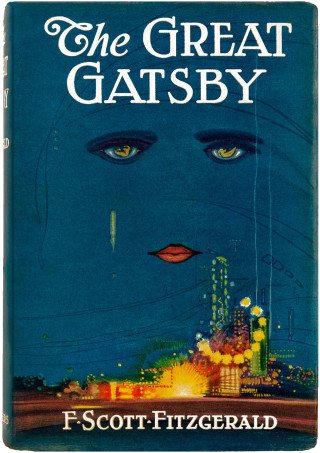The Great Gatsby, unlike Fitzgerald’s first two novels, is as carefully and closely composed as a lyric poem. This time, Fitzgerald wrote slowly, with painstaking attention to each word, and the text is accordingly about a third the length of its rapidly written semi-potboiler precursors. Like a lyric poem — like his beloved Keats’ “Ode on a Grecian Urn” — The Great Gatsby is narrated by a sensitive speaker circling a magnetic and mysterious object, in this case Gatsby’s (corruptly) self-made prominence and doomed attempt to win Daisy from her cruel husband Tom, a situation radiant with both ecstatic desire and grisly violence, frozen in a frieze of evocative language and elusive symbols the meaning of which the narrator finally leaves for us to decide.
Granted, the moralist in Fitzgerald remains active in the novel with narrator Nick Carraway’s famous final censure of Tom and Daisy as “careless people.” The disappointed male lover’s wounded propensity to make women’s immoderate and shallow desire symbolic of civilization’s whole decay, as in The Beautiful and Damned, recurs in the gruesome fate the narrative deals out to Tom’s mistress Myrtle Wilson in the culminating car accident — “her left breast was swinging loose like a flap” — which is just the obverse of the conclusion’s equally and oppositely unreal idealization of “the fresh green breast of the new world.”
But whereas the earlier novels, especially the New York-set The Beautiful and Damned, stereotypes the heterogeneous modern world’s diverse inhabitants with invidious and at times hateful portraits of Jewish-, Italian-, African-, and Asian-Americans — and therefore, incidentally, bely the still somehow fashionable idea that social novels automatically possess a humanistic social conscience — the observant eye of Nick Carraway understands the porousness of modern cultures, races, religions, and selves to be the precondition for Gatsby’s own rise:
A dead man passed us in a hearse heaped with blooms, followed by two carriages with drawn blinds, and by more cheerful carriages for friends. The friends looked out at us with the tragic eyes and short upper lips of southeastern Europe, and I was glad that the sight of Gatsby’s splendid car was included in their sombre holiday. As we crossed Blackwell’s Island a limousine passed us, driven by a white chauffeur, in which sat three modish negroes, two bucks and a girl. I laughed aloud as the yolks of their eyeballs rolled toward us in haughty rivalry.
“Anything can happen now that we’ve slid over this bridge,” I thought; “anything at all . . . ”
Even Gatsby could happen, without any particular wonder.
As for capitalism, one of Gatsby and Nick’s last conversations about Daisy, circling the mystery of her voice that has haunted the narrator from its beginning, comes to the conclusion that her aesthetic and erotic appeal, like that of the novel’s own style, resembles currency.
“She’s got an indiscreet voice,” I remarked. “It’s full of — ” I hesitated.
“Her voice is full of money,” he said suddenly.
That was it. I’d never understood before. It was full of money — that was the inexhaustible charm that rose and fell in it, the jingle of it, the cymbals’ song of it . . . . High in a white palace the king’s daughter, the golden girl . . . .
